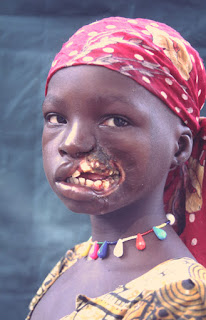This condition is known as Noma (Cancrum oris) and is typically found in children who are chronically malnourished, or after an epidemic of measles, diarrhea, or malaria.
Nicknamed the "forgotten disease of the poor," this disfiguring condition begins as a gingival ulcer and spreads rapidly through the tissues of the mouth and face including muscle and bone to become an acute necrotizing ulcerative stomatitis.
It is one of the most devastating human diseases worldwide with a rapid, life-threatening course and has been designated a health priority by the WHO.
Noma is a polymicrobial infection associated predominantly with anaerobic organisms including Fusobacterium necrophorum.
How is Noma treated?
Treatment is aimed at symptomatic control of infection using a broad range of antibiotics, including metronidazole, penicillin, and streptomycin.
In managing Noma, the following steps should be considered:
- Stabilize the patient, and consider hydration and nutritional support;
- Administer appropriate antibiotics;
- Clean and dress the wound, minimizing wound trauma; perform as little surgical intervention as necessary; and
- Wait for 1-2 years before initiating any reconstructive surgery.
An emphasis on effective oral hygiene, clean water, and oral rehydration therapy, if necessary, in cases of dehydration from diarrhea, are excellent preventive strategies. Animals should be separated from living quarters in rural areas. In addition, standard immunizations for vaccine-preventable diseases, such as measles, mumps, and rubella, should be considered for all children. The treatment of infected pregnant and lactating women with antimalarials or standard tuberculosis therapy is another key preventive strategy.
Credit: Cyril O. Enwonwu, ScD, Ph.D., MDS, BDS
Use any of these to join us:
Email: healththenmore@gmail.com
Instagram: @healththenmore
Twitter: @healththenmore
YouTube Channel: HealthThenMore



Comments
Post a Comment